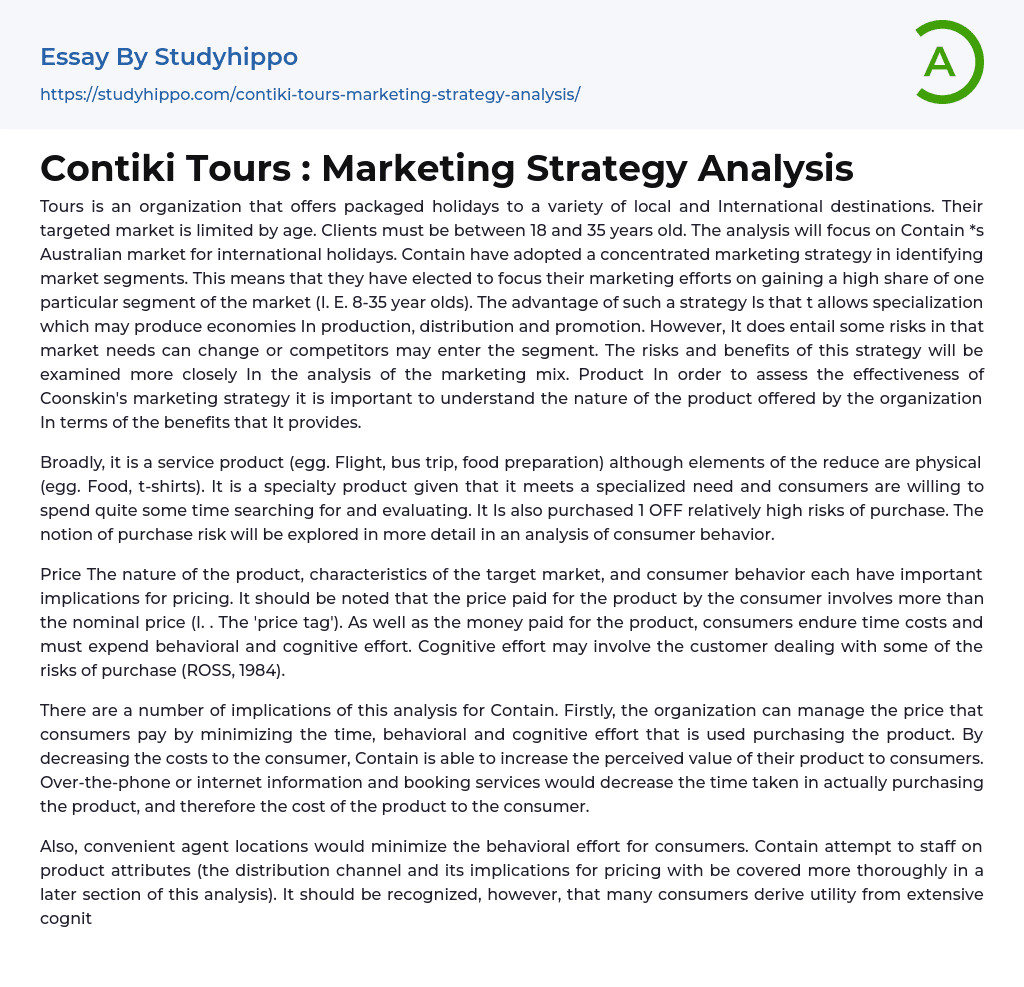Tours is an organization that offers packaged holidays to a variety of local and International destinations. Their targeted market is limited by age. Clients must be between 18 and 35 years old. The analysis will focus on Contain *s Australian market for international holidays. Contain have adopted a concentrated marketing strategy in identifying market segments. This means that they have elected to focus their marketing efforts on gaining a high share of one particular segment of the market (I. E. 8-35 year olds). The advantage of such a strategy Is that t allows specialization which may produce economies In production, distribution and promotion. However, It does entail some risks in that market needs can change or competitors may enter the segment. The risks and benefits of this strategy will be examined more closely In the analysis of the marketing
...mix. Product In order to assess the effectiveness of Coonskin's marketing strategy it is important to understand the nature of the product offered by the organization In terms of the benefits that It provides.
Broadly, it is a service product (egg. Flight, bus trip, food preparation) although elements of the reduce are physical (egg. Food, t-shirts). It is a specialty product given that it meets a specialized need and consumers are willing to spend quite some time searching for and evaluating. It Is also purchased 1 OFF relatively high risks of purchase. The notion of purchase risk will be explored in more detail in an analysis of consumer behavior.
Price The nature of the product, characteristics of the target market, and consumer behavior each have important implications for pricing. It should be noted that the
price paid for the product by the consumer involves more than the nominal price (I. . The 'price tag'). As well as the money paid for the product, consumers endure time costs and must expend behavioral and cognitive effort. Cognitive effort may involve the customer dealing with some of the risks of purchase (ROSS, 1984).
There are a number of implications of this analysis for Contain. Firstly, the organization can manage the price that consumers pay by minimizing the time, behavioral and cognitive effort that is used purchasing the product. By decreasing the costs to the consumer, Contain is able to increase the perceived value of their product to consumers. Over-the-phone or internet information and booking services would decrease the time taken in actually purchasing the product, and therefore the cost of the product to the consumer.
Also, convenient agent locations would minimize the behavioral effort for consumers. Contain attempt to staff on product attributes (the distribution channel and its implications for pricing with be covered more thoroughly in a later section of this analysis). It should be recognized, however, that many consumers derive utility from extensive cognitive involvement in the purchase process. For example, some customers ay enjoy discussing at length with consultants, their itinerary and travel options.
- Competition essays
- Effective Leadership essays
- Leadership Styles essays
- Public relations essays
- Planning essays
- Mission Statement essays
- Outsourcing essays
- Swot Analysis essays
- Business Analysis essays
- Business Plan essays
- Strategic Management essays
- Strategic Planning essays
- Reasoning essays
- Community Development essays
- Negotiation essays
- Consumer behaviour essays
- Advertisement essays
- Advertising essays
- Anheuser-busch essays
- Audience Theory essays
- Brand essays
- Brands essays
- Competitor Analysis essays
- Consumer essays
- Detergent essays
- Marketing Management essays
- Marketing Mix essays
- Marketing Plan essays
- Marketing Research essays
- Marketing Strategy essays
- New Product Development essays
- Point Of Sale essays
- Price essays
- Procurement essays
- Product essays
- Product Differentiation essays
- Product Placement essays
- Promotion essays
- Promotion And Marketing Communications essays
- Research Design essays
- Retailing essays
- Trademark essays
- Accounting essays
- Andrew Carnegie essays
- Automation essays
- Business Cycle essays
- Business Intelligence essays
- Business Model essays
- Business Operations essays
- Business Software essays




